Amazon’s Operations Management and Decision-Making Models
VerifiedAdded on 2023/01/19
|12
|3160
|46
AI Summary
This document discusses the growth of Amazon from an online book retailer to the 'everything store' and explores the aspects of its operations management that are based on the increased globalization of world trade. It also examines whether e-commerce can truly replace the in-person shopping experience and discusses the long-term implications of Amazon's presence on the Australian retail industry.
Contribute Materials
Your contribution can guide someone’s learning journey. Share your
documents today.

AMAZON’S OPERATIONS MANAGEMENT AND DECISION-MAKING MODELS 1
Amazon’s Operations Management and Decision-Making Models
Name:
Institution:
Course:
Tutor
Amazon’s Operations Management and Decision-Making Models
Name:
Institution:
Course:
Tutor
Secure Best Marks with AI Grader
Need help grading? Try our AI Grader for instant feedback on your assignments.
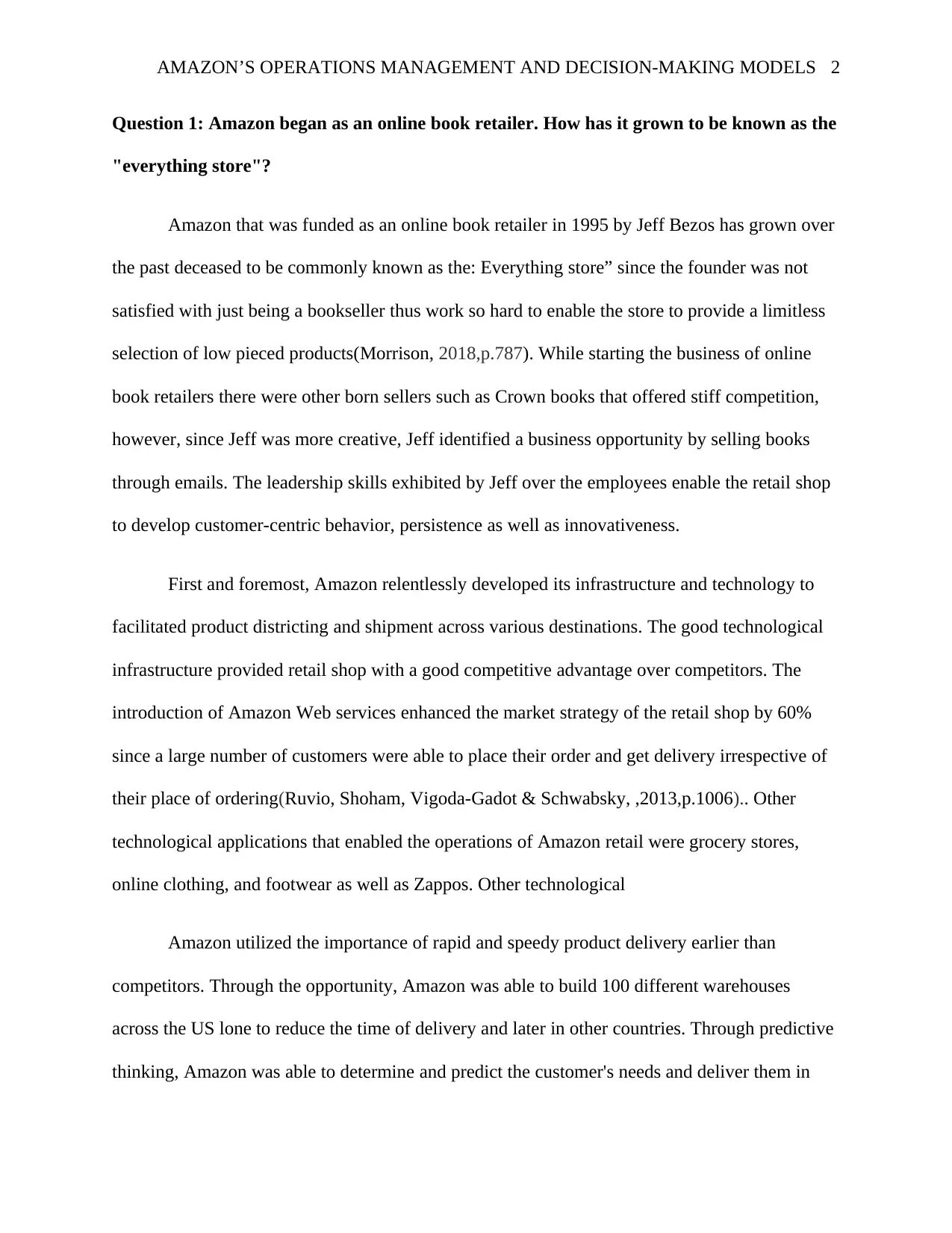
AMAZON’S OPERATIONS MANAGEMENT AND DECISION-MAKING MODELS 2
Question 1: Amazon began as an online book retailer. How has it grown to be known as the
"everything store"?
Amazon that was funded as an online book retailer in 1995 by Jeff Bezos has grown over
the past deceased to be commonly known as the: Everything store” since the founder was not
satisfied with just being a bookseller thus work so hard to enable the store to provide a limitless
selection of low pieced products(Morrison, 2018,p.787). While starting the business of online
book retailers there were other born sellers such as Crown books that offered stiff competition,
however, since Jeff was more creative, Jeff identified a business opportunity by selling books
through emails. The leadership skills exhibited by Jeff over the employees enable the retail shop
to develop customer-centric behavior, persistence as well as innovativeness.
First and foremost, Amazon relentlessly developed its infrastructure and technology to
facilitated product districting and shipment across various destinations. The good technological
infrastructure provided retail shop with a good competitive advantage over competitors. The
introduction of Amazon Web services enhanced the market strategy of the retail shop by 60%
since a large number of customers were able to place their order and get delivery irrespective of
their place of ordering(Ruvio, Shoham, Vigoda-Gadot & Schwabsky, ,2013,p.1006).. Other
technological applications that enabled the operations of Amazon retail were grocery stores,
online clothing, and footwear as well as Zappos. Other technological
Amazon utilized the importance of rapid and speedy product delivery earlier than
competitors. Through the opportunity, Amazon was able to build 100 different warehouses
across the US lone to reduce the time of delivery and later in other countries. Through predictive
thinking, Amazon was able to determine and predict the customer's needs and deliver them in
Question 1: Amazon began as an online book retailer. How has it grown to be known as the
"everything store"?
Amazon that was funded as an online book retailer in 1995 by Jeff Bezos has grown over
the past deceased to be commonly known as the: Everything store” since the founder was not
satisfied with just being a bookseller thus work so hard to enable the store to provide a limitless
selection of low pieced products(Morrison, 2018,p.787). While starting the business of online
book retailers there were other born sellers such as Crown books that offered stiff competition,
however, since Jeff was more creative, Jeff identified a business opportunity by selling books
through emails. The leadership skills exhibited by Jeff over the employees enable the retail shop
to develop customer-centric behavior, persistence as well as innovativeness.
First and foremost, Amazon relentlessly developed its infrastructure and technology to
facilitated product districting and shipment across various destinations. The good technological
infrastructure provided retail shop with a good competitive advantage over competitors. The
introduction of Amazon Web services enhanced the market strategy of the retail shop by 60%
since a large number of customers were able to place their order and get delivery irrespective of
their place of ordering(Ruvio, Shoham, Vigoda-Gadot & Schwabsky, ,2013,p.1006).. Other
technological applications that enabled the operations of Amazon retail were grocery stores,
online clothing, and footwear as well as Zappos. Other technological
Amazon utilized the importance of rapid and speedy product delivery earlier than
competitors. Through the opportunity, Amazon was able to build 100 different warehouses
across the US lone to reduce the time of delivery and later in other countries. Through predictive
thinking, Amazon was able to determine and predict the customer's needs and deliver them in
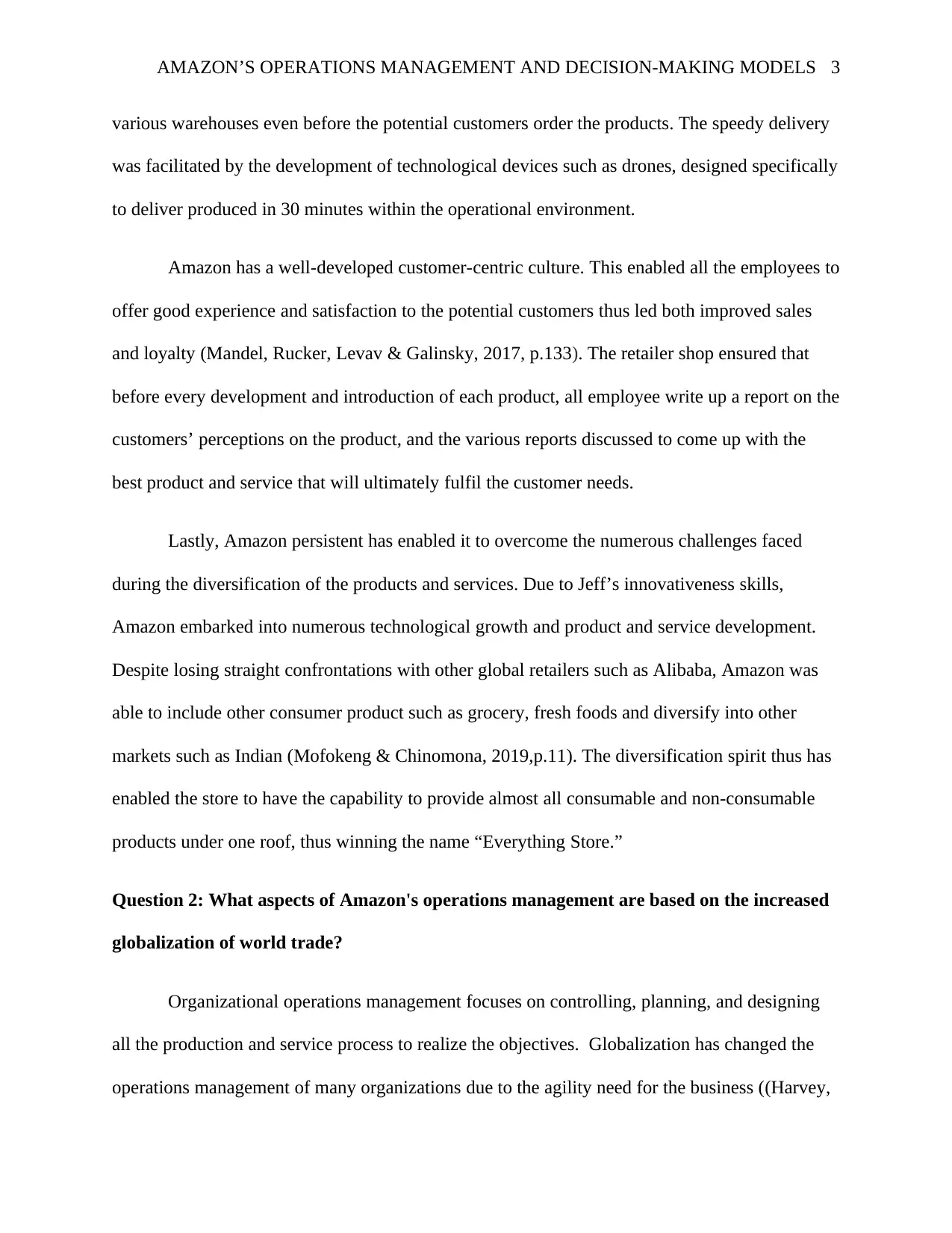
AMAZON’S OPERATIONS MANAGEMENT AND DECISION-MAKING MODELS 3
various warehouses even before the potential customers order the products. The speedy delivery
was facilitated by the development of technological devices such as drones, designed specifically
to deliver produced in 30 minutes within the operational environment.
Amazon has a well-developed customer-centric culture. This enabled all the employees to
offer good experience and satisfaction to the potential customers thus led both improved sales
and loyalty (Mandel, Rucker, Levav & Galinsky, 2017, p.133). The retailer shop ensured that
before every development and introduction of each product, all employee write up a report on the
customers’ perceptions on the product, and the various reports discussed to come up with the
best product and service that will ultimately fulfil the customer needs.
Lastly, Amazon persistent has enabled it to overcome the numerous challenges faced
during the diversification of the products and services. Due to Jeff’s innovativeness skills,
Amazon embarked into numerous technological growth and product and service development.
Despite losing straight confrontations with other global retailers such as Alibaba, Amazon was
able to include other consumer product such as grocery, fresh foods and diversify into other
markets such as Indian (Mofokeng & Chinomona, 2019,p.11). The diversification spirit thus has
enabled the store to have the capability to provide almost all consumable and non-consumable
products under one roof, thus winning the name “Everything Store.”
Question 2: What aspects of Amazon's operations management are based on the increased
globalization of world trade?
Organizational operations management focuses on controlling, planning, and designing
all the production and service process to realize the objectives. Globalization has changed the
operations management of many organizations due to the agility need for the business ((Harvey,
various warehouses even before the potential customers order the products. The speedy delivery
was facilitated by the development of technological devices such as drones, designed specifically
to deliver produced in 30 minutes within the operational environment.
Amazon has a well-developed customer-centric culture. This enabled all the employees to
offer good experience and satisfaction to the potential customers thus led both improved sales
and loyalty (Mandel, Rucker, Levav & Galinsky, 2017, p.133). The retailer shop ensured that
before every development and introduction of each product, all employee write up a report on the
customers’ perceptions on the product, and the various reports discussed to come up with the
best product and service that will ultimately fulfil the customer needs.
Lastly, Amazon persistent has enabled it to overcome the numerous challenges faced
during the diversification of the products and services. Due to Jeff’s innovativeness skills,
Amazon embarked into numerous technological growth and product and service development.
Despite losing straight confrontations with other global retailers such as Alibaba, Amazon was
able to include other consumer product such as grocery, fresh foods and diversify into other
markets such as Indian (Mofokeng & Chinomona, 2019,p.11). The diversification spirit thus has
enabled the store to have the capability to provide almost all consumable and non-consumable
products under one roof, thus winning the name “Everything Store.”
Question 2: What aspects of Amazon's operations management are based on the increased
globalization of world trade?
Organizational operations management focuses on controlling, planning, and designing
all the production and service process to realize the objectives. Globalization has changed the
operations management of many organizations due to the agility need for the business ((Harvey,
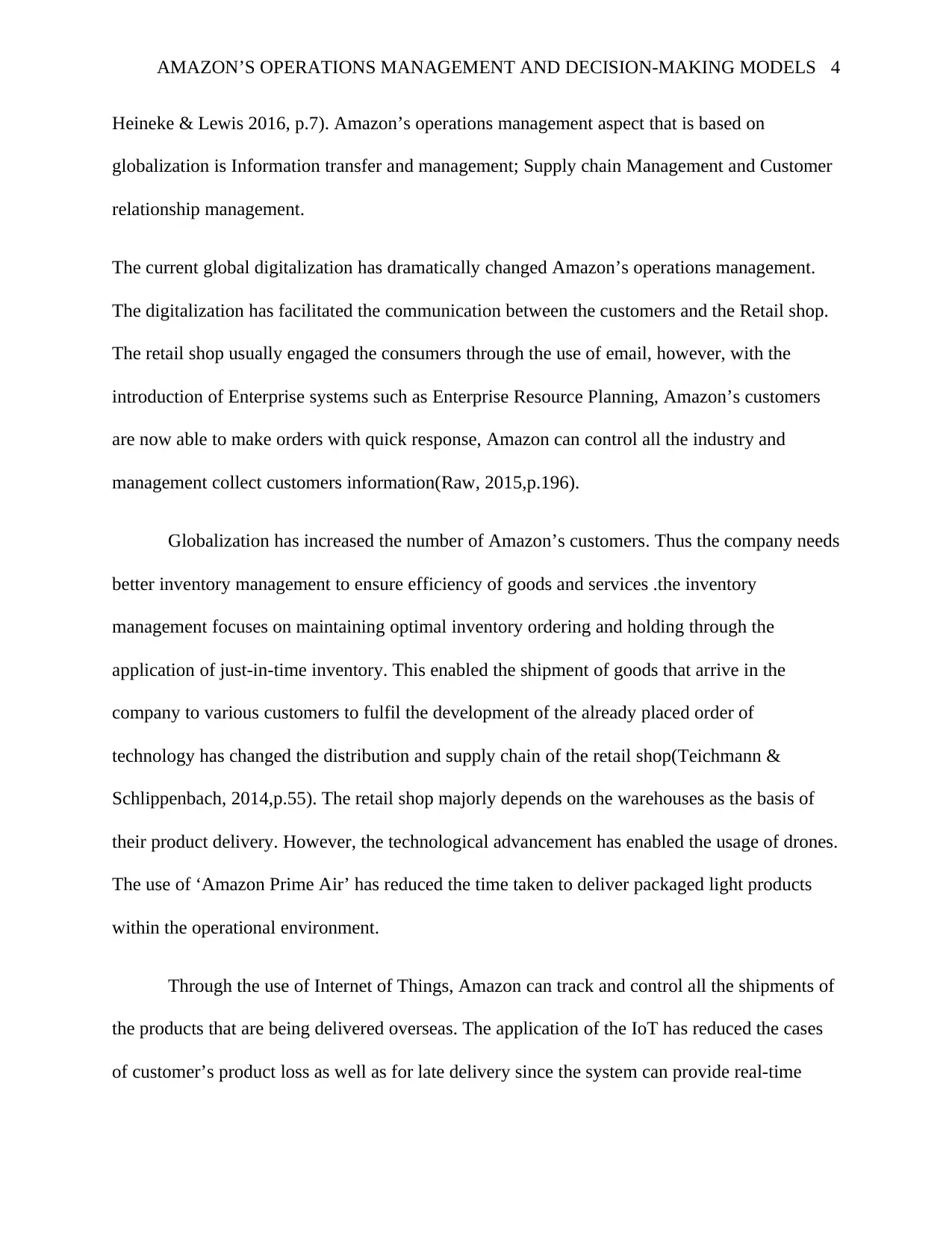
AMAZON’S OPERATIONS MANAGEMENT AND DECISION-MAKING MODELS 4
Heineke & Lewis 2016, p.7). Amazon’s operations management aspect that is based on
globalization is Information transfer and management; Supply chain Management and Customer
relationship management.
The current global digitalization has dramatically changed Amazon’s operations management.
The digitalization has facilitated the communication between the customers and the Retail shop.
The retail shop usually engaged the consumers through the use of email, however, with the
introduction of Enterprise systems such as Enterprise Resource Planning, Amazon’s customers
are now able to make orders with quick response, Amazon can control all the industry and
management collect customers information(Raw, 2015,p.196).
Globalization has increased the number of Amazon’s customers. Thus the company needs
better inventory management to ensure efficiency of goods and services .the inventory
management focuses on maintaining optimal inventory ordering and holding through the
application of just-in-time inventory. This enabled the shipment of goods that arrive in the
company to various customers to fulfil the development of the already placed order of
technology has changed the distribution and supply chain of the retail shop(Teichmann &
Schlippenbach, 2014,p.55). The retail shop majorly depends on the warehouses as the basis of
their product delivery. However, the technological advancement has enabled the usage of drones.
The use of ‘Amazon Prime Air’ has reduced the time taken to deliver packaged light products
within the operational environment.
Through the use of Internet of Things, Amazon can track and control all the shipments of
the products that are being delivered overseas. The application of the IoT has reduced the cases
of customer’s product loss as well as for late delivery since the system can provide real-time
Heineke & Lewis 2016, p.7). Amazon’s operations management aspect that is based on
globalization is Information transfer and management; Supply chain Management and Customer
relationship management.
The current global digitalization has dramatically changed Amazon’s operations management.
The digitalization has facilitated the communication between the customers and the Retail shop.
The retail shop usually engaged the consumers through the use of email, however, with the
introduction of Enterprise systems such as Enterprise Resource Planning, Amazon’s customers
are now able to make orders with quick response, Amazon can control all the industry and
management collect customers information(Raw, 2015,p.196).
Globalization has increased the number of Amazon’s customers. Thus the company needs
better inventory management to ensure efficiency of goods and services .the inventory
management focuses on maintaining optimal inventory ordering and holding through the
application of just-in-time inventory. This enabled the shipment of goods that arrive in the
company to various customers to fulfil the development of the already placed order of
technology has changed the distribution and supply chain of the retail shop(Teichmann &
Schlippenbach, 2014,p.55). The retail shop majorly depends on the warehouses as the basis of
their product delivery. However, the technological advancement has enabled the usage of drones.
The use of ‘Amazon Prime Air’ has reduced the time taken to deliver packaged light products
within the operational environment.
Through the use of Internet of Things, Amazon can track and control all the shipments of
the products that are being delivered overseas. The application of the IoT has reduced the cases
of customer’s product loss as well as for late delivery since the system can provide real-time
Secure Best Marks with AI Grader
Need help grading? Try our AI Grader for instant feedback on your assignments.
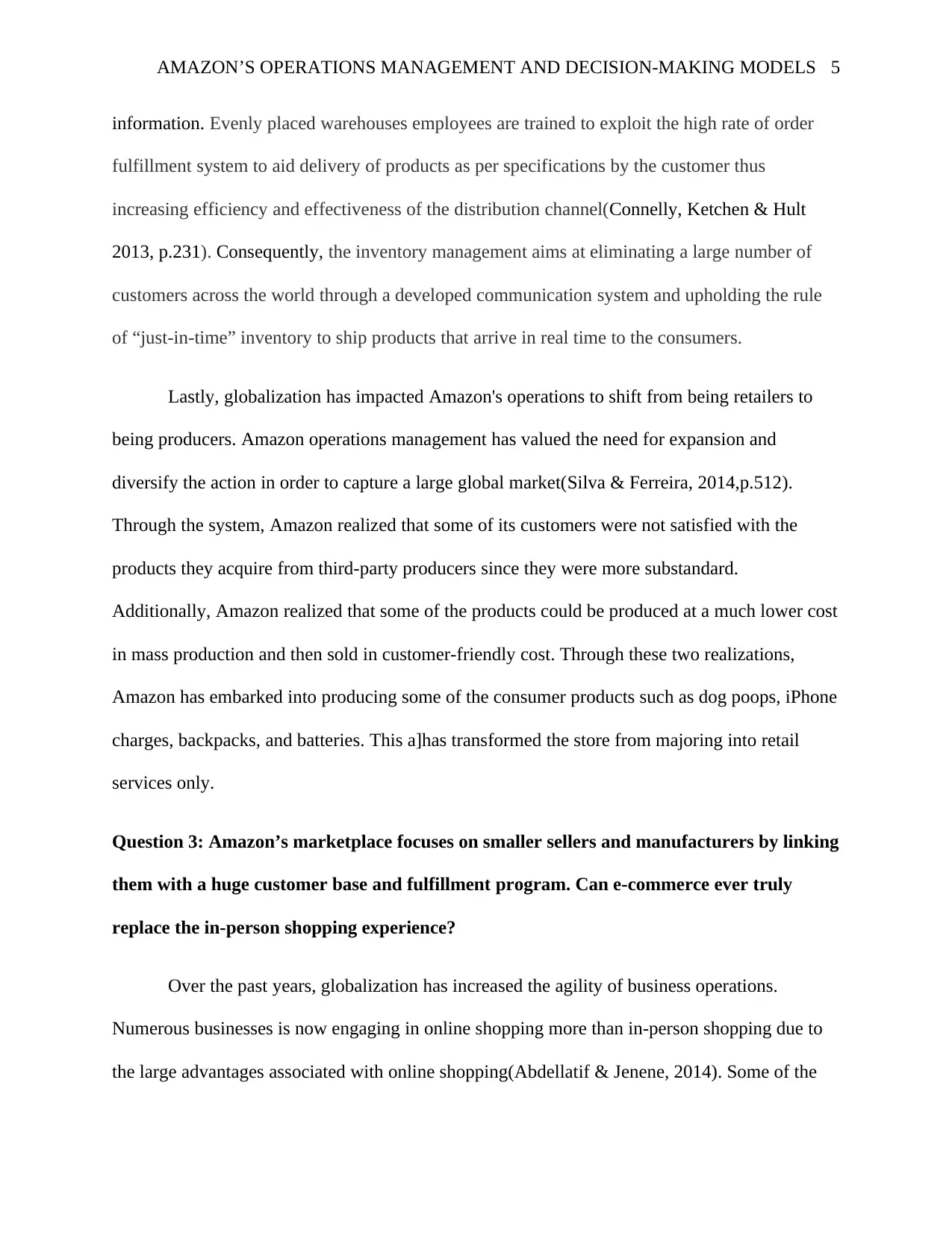
AMAZON’S OPERATIONS MANAGEMENT AND DECISION-MAKING MODELS 5
information. Evenly placed warehouses employees are trained to exploit the high rate of order
fulfillment system to aid delivery of products as per specifications by the customer thus
increasing efficiency and effectiveness of the distribution channel(Connelly, Ketchen & Hult
2013, p.231). Consequently, the inventory management aims at eliminating a large number of
customers across the world through a developed communication system and upholding the rule
of “just-in-time” inventory to ship products that arrive in real time to the consumers.
Lastly, globalization has impacted Amazon's operations to shift from being retailers to
being producers. Amazon operations management has valued the need for expansion and
diversify the action in order to capture a large global market(Silva & Ferreira, 2014,p.512).
Through the system, Amazon realized that some of its customers were not satisfied with the
products they acquire from third-party producers since they were more substandard.
Additionally, Amazon realized that some of the products could be produced at a much lower cost
in mass production and then sold in customer-friendly cost. Through these two realizations,
Amazon has embarked into producing some of the consumer products such as dog poops, iPhone
charges, backpacks, and batteries. This a]has transformed the store from majoring into retail
services only.
Question 3: Amazon’s marketplace focuses on smaller sellers and manufacturers by linking
them with a huge customer base and fulfillment program. Can e-commerce ever truly
replace the in-person shopping experience?
Over the past years, globalization has increased the agility of business operations.
Numerous businesses is now engaging in online shopping more than in-person shopping due to
the large advantages associated with online shopping(Abdellatif & Jenene, 2014). Some of the
information. Evenly placed warehouses employees are trained to exploit the high rate of order
fulfillment system to aid delivery of products as per specifications by the customer thus
increasing efficiency and effectiveness of the distribution channel(Connelly, Ketchen & Hult
2013, p.231). Consequently, the inventory management aims at eliminating a large number of
customers across the world through a developed communication system and upholding the rule
of “just-in-time” inventory to ship products that arrive in real time to the consumers.
Lastly, globalization has impacted Amazon's operations to shift from being retailers to
being producers. Amazon operations management has valued the need for expansion and
diversify the action in order to capture a large global market(Silva & Ferreira, 2014,p.512).
Through the system, Amazon realized that some of its customers were not satisfied with the
products they acquire from third-party producers since they were more substandard.
Additionally, Amazon realized that some of the products could be produced at a much lower cost
in mass production and then sold in customer-friendly cost. Through these two realizations,
Amazon has embarked into producing some of the consumer products such as dog poops, iPhone
charges, backpacks, and batteries. This a]has transformed the store from majoring into retail
services only.
Question 3: Amazon’s marketplace focuses on smaller sellers and manufacturers by linking
them with a huge customer base and fulfillment program. Can e-commerce ever truly
replace the in-person shopping experience?
Over the past years, globalization has increased the agility of business operations.
Numerous businesses is now engaging in online shopping more than in-person shopping due to
the large advantages associated with online shopping(Abdellatif & Jenene, 2014). Some of the
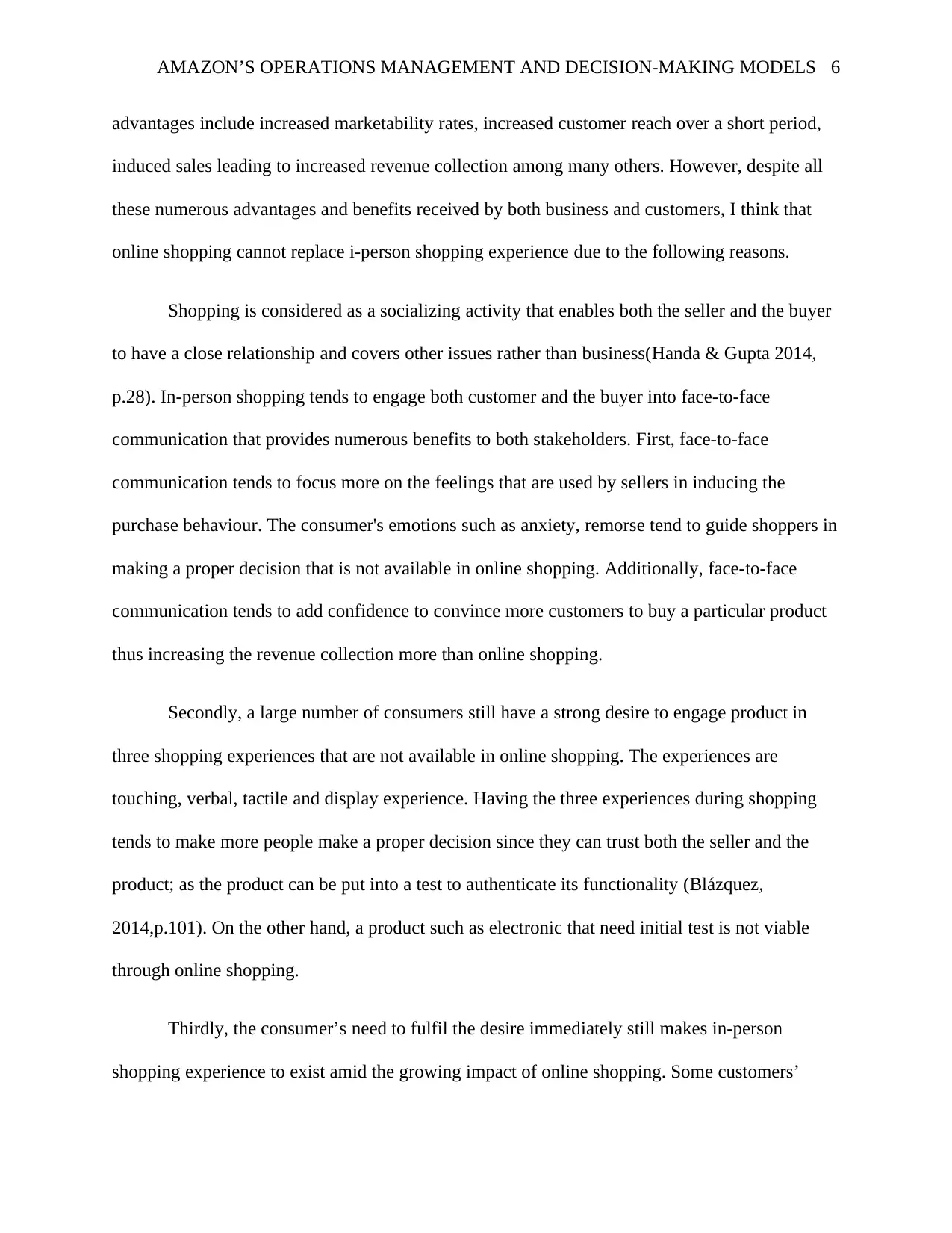
AMAZON’S OPERATIONS MANAGEMENT AND DECISION-MAKING MODELS 6
advantages include increased marketability rates, increased customer reach over a short period,
induced sales leading to increased revenue collection among many others. However, despite all
these numerous advantages and benefits received by both business and customers, I think that
online shopping cannot replace i-person shopping experience due to the following reasons.
Shopping is considered as a socializing activity that enables both the seller and the buyer
to have a close relationship and covers other issues rather than business(Handa & Gupta 2014,
p.28). In-person shopping tends to engage both customer and the buyer into face-to-face
communication that provides numerous benefits to both stakeholders. First, face-to-face
communication tends to focus more on the feelings that are used by sellers in inducing the
purchase behaviour. The consumer's emotions such as anxiety, remorse tend to guide shoppers in
making a proper decision that is not available in online shopping. Additionally, face-to-face
communication tends to add confidence to convince more customers to buy a particular product
thus increasing the revenue collection more than online shopping.
Secondly, a large number of consumers still have a strong desire to engage product in
three shopping experiences that are not available in online shopping. The experiences are
touching, verbal, tactile and display experience. Having the three experiences during shopping
tends to make more people make a proper decision since they can trust both the seller and the
product; as the product can be put into a test to authenticate its functionality (Blázquez,
2014,p.101). On the other hand, a product such as electronic that need initial test is not viable
through online shopping.
Thirdly, the consumer’s need to fulfil the desire immediately still makes in-person
shopping experience to exist amid the growing impact of online shopping. Some customers’
advantages include increased marketability rates, increased customer reach over a short period,
induced sales leading to increased revenue collection among many others. However, despite all
these numerous advantages and benefits received by both business and customers, I think that
online shopping cannot replace i-person shopping experience due to the following reasons.
Shopping is considered as a socializing activity that enables both the seller and the buyer
to have a close relationship and covers other issues rather than business(Handa & Gupta 2014,
p.28). In-person shopping tends to engage both customer and the buyer into face-to-face
communication that provides numerous benefits to both stakeholders. First, face-to-face
communication tends to focus more on the feelings that are used by sellers in inducing the
purchase behaviour. The consumer's emotions such as anxiety, remorse tend to guide shoppers in
making a proper decision that is not available in online shopping. Additionally, face-to-face
communication tends to add confidence to convince more customers to buy a particular product
thus increasing the revenue collection more than online shopping.
Secondly, a large number of consumers still have a strong desire to engage product in
three shopping experiences that are not available in online shopping. The experiences are
touching, verbal, tactile and display experience. Having the three experiences during shopping
tends to make more people make a proper decision since they can trust both the seller and the
product; as the product can be put into a test to authenticate its functionality (Blázquez,
2014,p.101). On the other hand, a product such as electronic that need initial test is not viable
through online shopping.
Thirdly, the consumer’s need to fulfil the desire immediately still makes in-person
shopping experience to exist amid the growing impact of online shopping. Some customers’
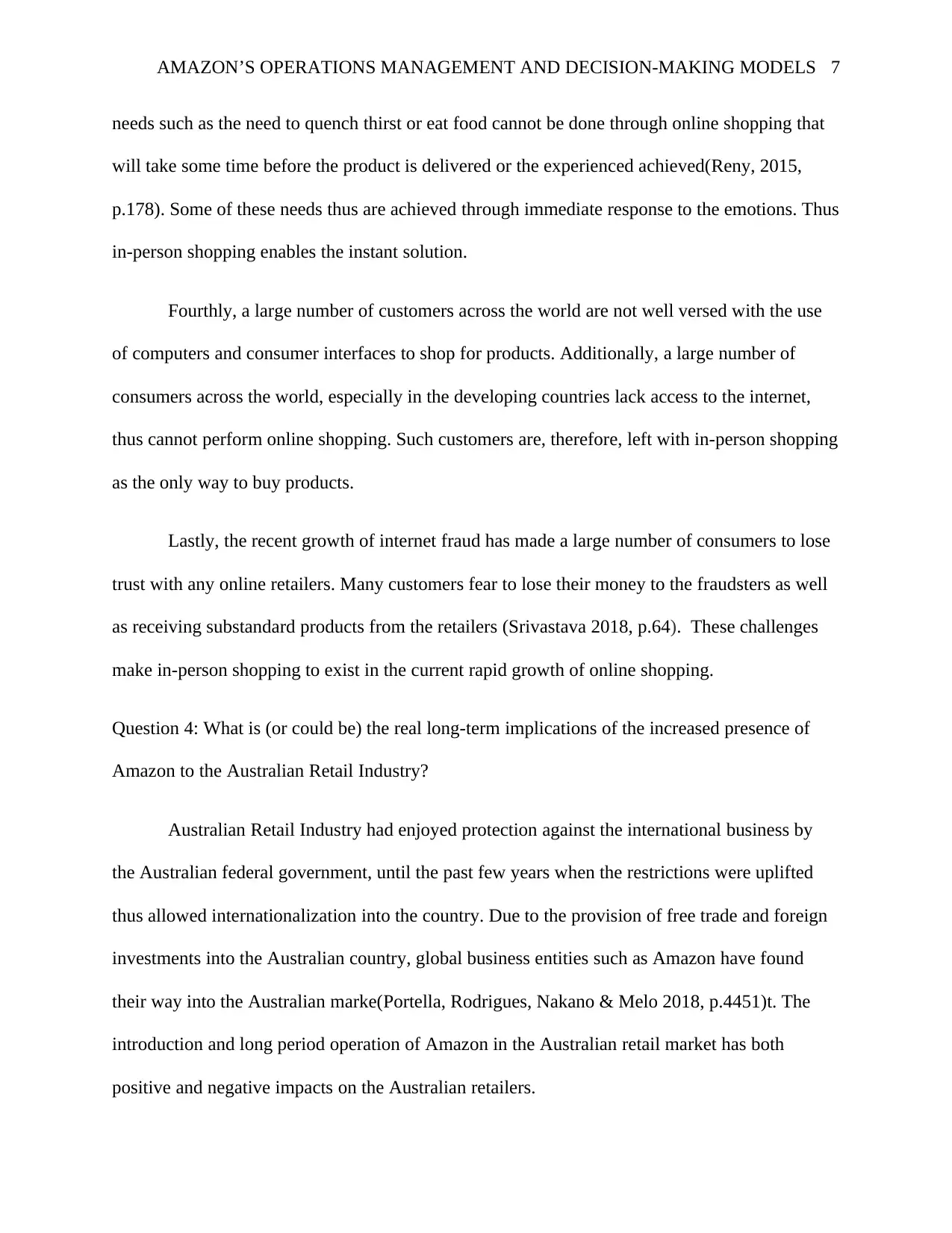
AMAZON’S OPERATIONS MANAGEMENT AND DECISION-MAKING MODELS 7
needs such as the need to quench thirst or eat food cannot be done through online shopping that
will take some time before the product is delivered or the experienced achieved(Reny, 2015,
p.178). Some of these needs thus are achieved through immediate response to the emotions. Thus
in-person shopping enables the instant solution.
Fourthly, a large number of customers across the world are not well versed with the use
of computers and consumer interfaces to shop for products. Additionally, a large number of
consumers across the world, especially in the developing countries lack access to the internet,
thus cannot perform online shopping. Such customers are, therefore, left with in-person shopping
as the only way to buy products.
Lastly, the recent growth of internet fraud has made a large number of consumers to lose
trust with any online retailers. Many customers fear to lose their money to the fraudsters as well
as receiving substandard products from the retailers (Srivastava 2018, p.64). These challenges
make in-person shopping to exist in the current rapid growth of online shopping.
Question 4: What is (or could be) the real long-term implications of the increased presence of
Amazon to the Australian Retail Industry?
Australian Retail Industry had enjoyed protection against the international business by
the Australian federal government, until the past few years when the restrictions were uplifted
thus allowed internationalization into the country. Due to the provision of free trade and foreign
investments into the Australian country, global business entities such as Amazon have found
their way into the Australian marke(Portella, Rodrigues, Nakano & Melo 2018, p.4451)t. The
introduction and long period operation of Amazon in the Australian retail market has both
positive and negative impacts on the Australian retailers.
needs such as the need to quench thirst or eat food cannot be done through online shopping that
will take some time before the product is delivered or the experienced achieved(Reny, 2015,
p.178). Some of these needs thus are achieved through immediate response to the emotions. Thus
in-person shopping enables the instant solution.
Fourthly, a large number of customers across the world are not well versed with the use
of computers and consumer interfaces to shop for products. Additionally, a large number of
consumers across the world, especially in the developing countries lack access to the internet,
thus cannot perform online shopping. Such customers are, therefore, left with in-person shopping
as the only way to buy products.
Lastly, the recent growth of internet fraud has made a large number of consumers to lose
trust with any online retailers. Many customers fear to lose their money to the fraudsters as well
as receiving substandard products from the retailers (Srivastava 2018, p.64). These challenges
make in-person shopping to exist in the current rapid growth of online shopping.
Question 4: What is (or could be) the real long-term implications of the increased presence of
Amazon to the Australian Retail Industry?
Australian Retail Industry had enjoyed protection against the international business by
the Australian federal government, until the past few years when the restrictions were uplifted
thus allowed internationalization into the country. Due to the provision of free trade and foreign
investments into the Australian country, global business entities such as Amazon have found
their way into the Australian marke(Portella, Rodrigues, Nakano & Melo 2018, p.4451)t. The
introduction and long period operation of Amazon in the Australian retail market has both
positive and negative impacts on the Australian retailers.
Paraphrase This Document
Need a fresh take? Get an instant paraphrase of this document with our AI Paraphraser
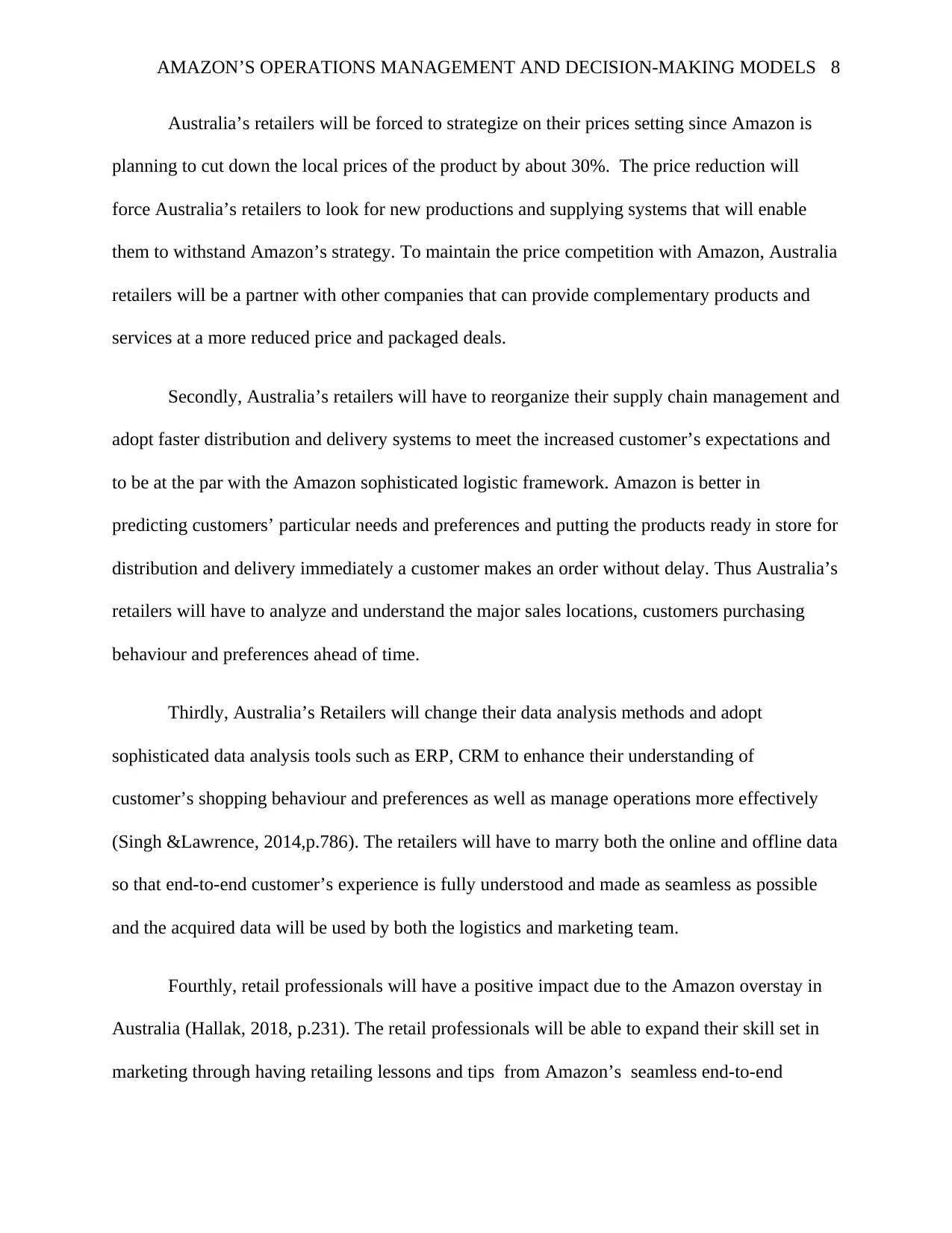
AMAZON’S OPERATIONS MANAGEMENT AND DECISION-MAKING MODELS 8
Australia’s retailers will be forced to strategize on their prices setting since Amazon is
planning to cut down the local prices of the product by about 30%. The price reduction will
force Australia’s retailers to look for new productions and supplying systems that will enable
them to withstand Amazon’s strategy. To maintain the price competition with Amazon, Australia
retailers will be a partner with other companies that can provide complementary products and
services at a more reduced price and packaged deals.
Secondly, Australia’s retailers will have to reorganize their supply chain management and
adopt faster distribution and delivery systems to meet the increased customer’s expectations and
to be at the par with the Amazon sophisticated logistic framework. Amazon is better in
predicting customers’ particular needs and preferences and putting the products ready in store for
distribution and delivery immediately a customer makes an order without delay. Thus Australia’s
retailers will have to analyze and understand the major sales locations, customers purchasing
behaviour and preferences ahead of time.
Thirdly, Australia’s Retailers will change their data analysis methods and adopt
sophisticated data analysis tools such as ERP, CRM to enhance their understanding of
customer’s shopping behaviour and preferences as well as manage operations more effectively
(Singh &Lawrence, 2014,p.786). The retailers will have to marry both the online and offline data
so that end-to-end customer’s experience is fully understood and made as seamless as possible
and the acquired data will be used by both the logistics and marketing team.
Fourthly, retail professionals will have a positive impact due to the Amazon overstay in
Australia (Hallak, 2018, p.231). The retail professionals will be able to expand their skill set in
marketing through having retailing lessons and tips from Amazon’s seamless end-to-end
Australia’s retailers will be forced to strategize on their prices setting since Amazon is
planning to cut down the local prices of the product by about 30%. The price reduction will
force Australia’s retailers to look for new productions and supplying systems that will enable
them to withstand Amazon’s strategy. To maintain the price competition with Amazon, Australia
retailers will be a partner with other companies that can provide complementary products and
services at a more reduced price and packaged deals.
Secondly, Australia’s retailers will have to reorganize their supply chain management and
adopt faster distribution and delivery systems to meet the increased customer’s expectations and
to be at the par with the Amazon sophisticated logistic framework. Amazon is better in
predicting customers’ particular needs and preferences and putting the products ready in store for
distribution and delivery immediately a customer makes an order without delay. Thus Australia’s
retailers will have to analyze and understand the major sales locations, customers purchasing
behaviour and preferences ahead of time.
Thirdly, Australia’s Retailers will change their data analysis methods and adopt
sophisticated data analysis tools such as ERP, CRM to enhance their understanding of
customer’s shopping behaviour and preferences as well as manage operations more effectively
(Singh &Lawrence, 2014,p.786). The retailers will have to marry both the online and offline data
so that end-to-end customer’s experience is fully understood and made as seamless as possible
and the acquired data will be used by both the logistics and marketing team.
Fourthly, retail professionals will have a positive impact due to the Amazon overstay in
Australia (Hallak, 2018, p.231). The retail professionals will be able to expand their skill set in
marketing through having retailing lessons and tips from Amazon’s seamless end-to-end
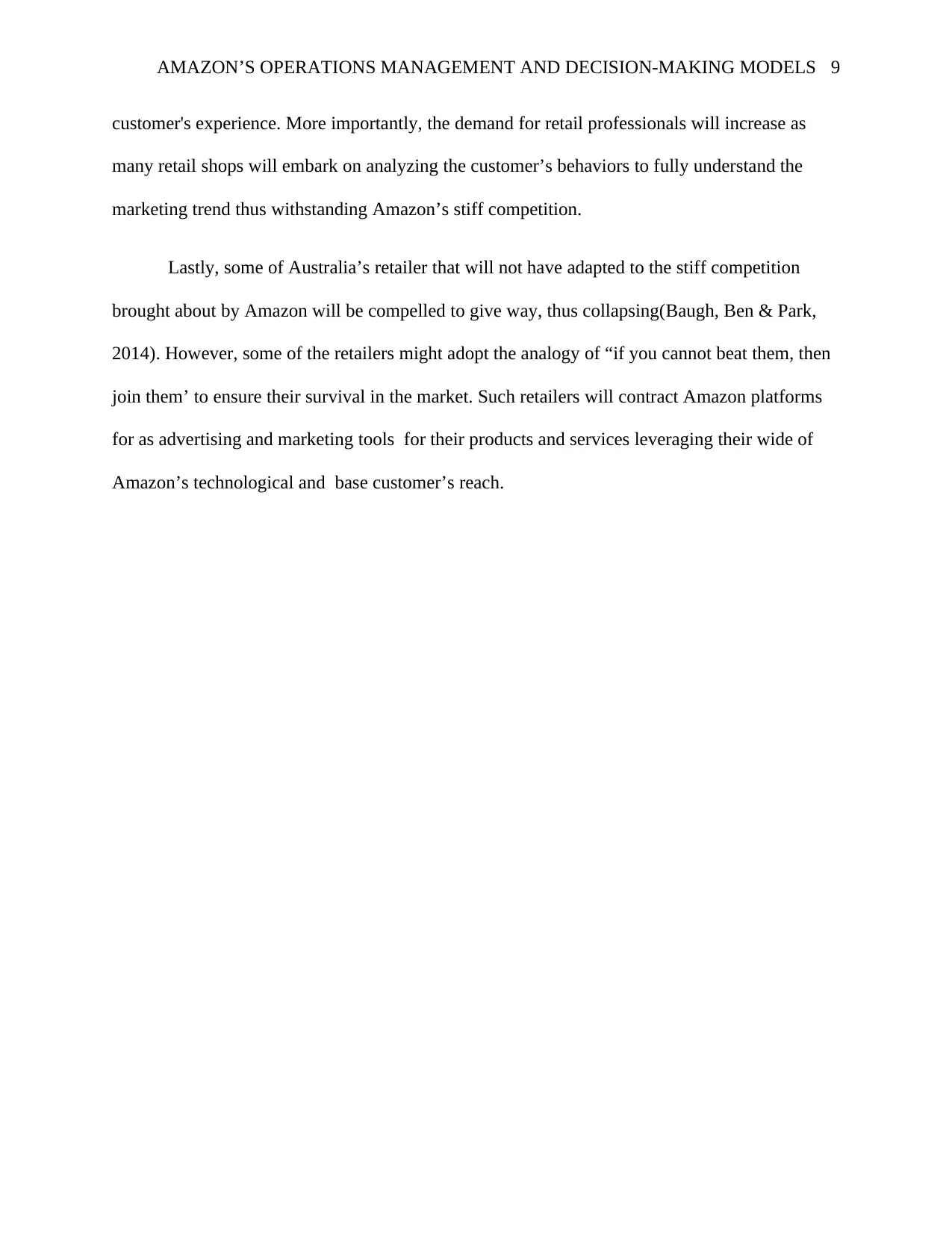
AMAZON’S OPERATIONS MANAGEMENT AND DECISION-MAKING MODELS 9
customer's experience. More importantly, the demand for retail professionals will increase as
many retail shops will embark on analyzing the customer’s behaviors to fully understand the
marketing trend thus withstanding Amazon’s stiff competition.
Lastly, some of Australia’s retailer that will not have adapted to the stiff competition
brought about by Amazon will be compelled to give way, thus collapsing(Baugh, Ben & Park,
2014). However, some of the retailers might adopt the analogy of “if you cannot beat them, then
join them’ to ensure their survival in the market. Such retailers will contract Amazon platforms
for as advertising and marketing tools for their products and services leveraging their wide of
Amazon’s technological and base customer’s reach.
customer's experience. More importantly, the demand for retail professionals will increase as
many retail shops will embark on analyzing the customer’s behaviors to fully understand the
marketing trend thus withstanding Amazon’s stiff competition.
Lastly, some of Australia’s retailer that will not have adapted to the stiff competition
brought about by Amazon will be compelled to give way, thus collapsing(Baugh, Ben & Park,
2014). However, some of the retailers might adopt the analogy of “if you cannot beat them, then
join them’ to ensure their survival in the market. Such retailers will contract Amazon platforms
for as advertising and marketing tools for their products and services leveraging their wide of
Amazon’s technological and base customer’s reach.
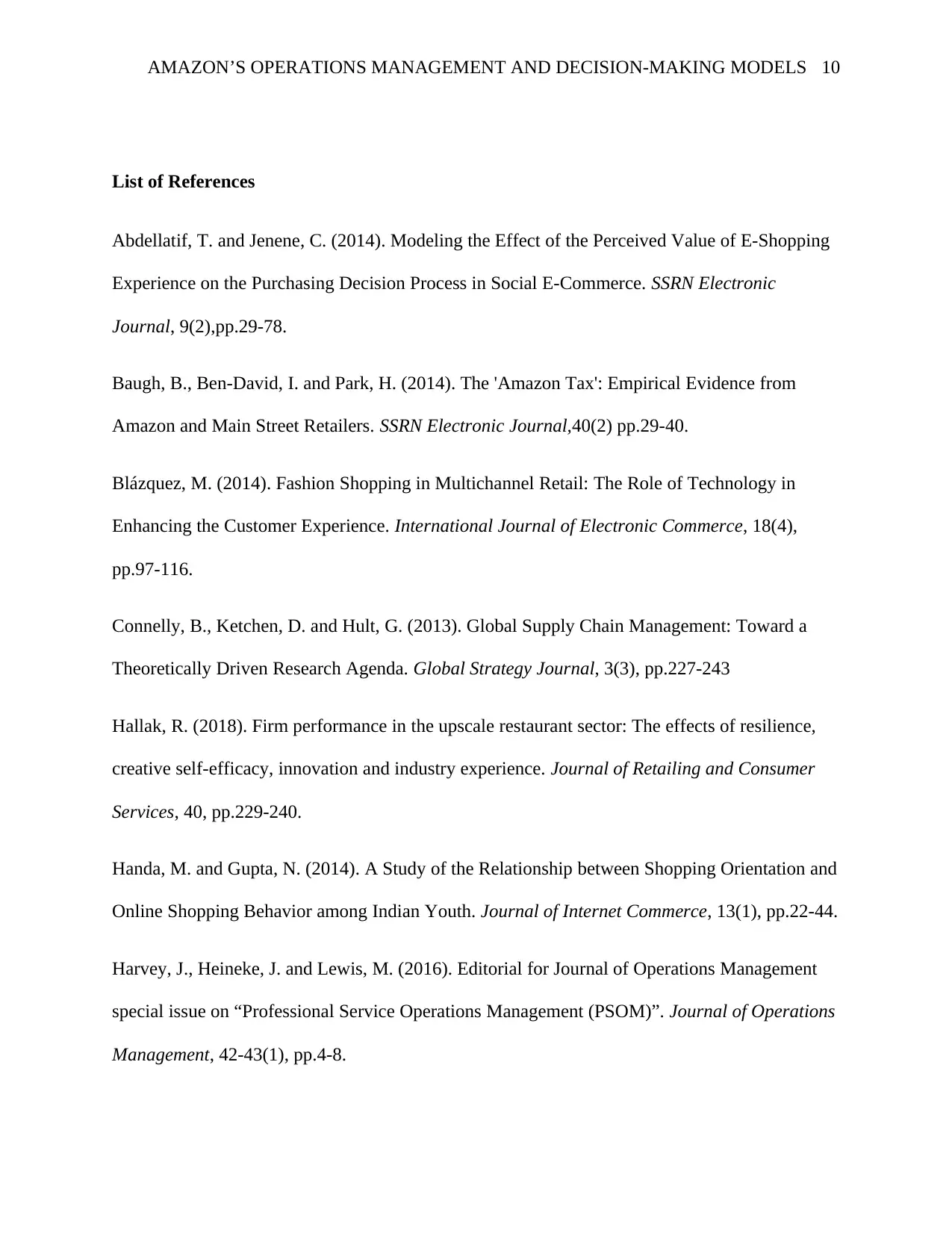
AMAZON’S OPERATIONS MANAGEMENT AND DECISION-MAKING MODELS 10
List of References
Abdellatif, T. and Jenene, C. (2014). Modeling the Effect of the Perceived Value of E-Shopping
Experience on the Purchasing Decision Process in Social E-Commerce. SSRN Electronic
Journal, 9(2),pp.29-78.
Baugh, B., Ben-David, I. and Park, H. (2014). The 'Amazon Tax': Empirical Evidence from
Amazon and Main Street Retailers. SSRN Electronic Journal,40(2) pp.29-40.
Blázquez, M. (2014). Fashion Shopping in Multichannel Retail: The Role of Technology in
Enhancing the Customer Experience. International Journal of Electronic Commerce, 18(4),
pp.97-116.
Connelly, B., Ketchen, D. and Hult, G. (2013). Global Supply Chain Management: Toward a
Theoretically Driven Research Agenda. Global Strategy Journal, 3(3), pp.227-243
Hallak, R. (2018). Firm performance in the upscale restaurant sector: The effects of resilience,
creative self-efficacy, innovation and industry experience. Journal of Retailing and Consumer
Services, 40, pp.229-240.
Handa, M. and Gupta, N. (2014). A Study of the Relationship between Shopping Orientation and
Online Shopping Behavior among Indian Youth. Journal of Internet Commerce, 13(1), pp.22-44.
Harvey, J., Heineke, J. and Lewis, M. (2016). Editorial for Journal of Operations Management
special issue on “Professional Service Operations Management (PSOM)”. Journal of Operations
Management, 42-43(1), pp.4-8.
List of References
Abdellatif, T. and Jenene, C. (2014). Modeling the Effect of the Perceived Value of E-Shopping
Experience on the Purchasing Decision Process in Social E-Commerce. SSRN Electronic
Journal, 9(2),pp.29-78.
Baugh, B., Ben-David, I. and Park, H. (2014). The 'Amazon Tax': Empirical Evidence from
Amazon and Main Street Retailers. SSRN Electronic Journal,40(2) pp.29-40.
Blázquez, M. (2014). Fashion Shopping in Multichannel Retail: The Role of Technology in
Enhancing the Customer Experience. International Journal of Electronic Commerce, 18(4),
pp.97-116.
Connelly, B., Ketchen, D. and Hult, G. (2013). Global Supply Chain Management: Toward a
Theoretically Driven Research Agenda. Global Strategy Journal, 3(3), pp.227-243
Hallak, R. (2018). Firm performance in the upscale restaurant sector: The effects of resilience,
creative self-efficacy, innovation and industry experience. Journal of Retailing and Consumer
Services, 40, pp.229-240.
Handa, M. and Gupta, N. (2014). A Study of the Relationship between Shopping Orientation and
Online Shopping Behavior among Indian Youth. Journal of Internet Commerce, 13(1), pp.22-44.
Harvey, J., Heineke, J. and Lewis, M. (2016). Editorial for Journal of Operations Management
special issue on “Professional Service Operations Management (PSOM)”. Journal of Operations
Management, 42-43(1), pp.4-8.
Secure Best Marks with AI Grader
Need help grading? Try our AI Grader for instant feedback on your assignments.
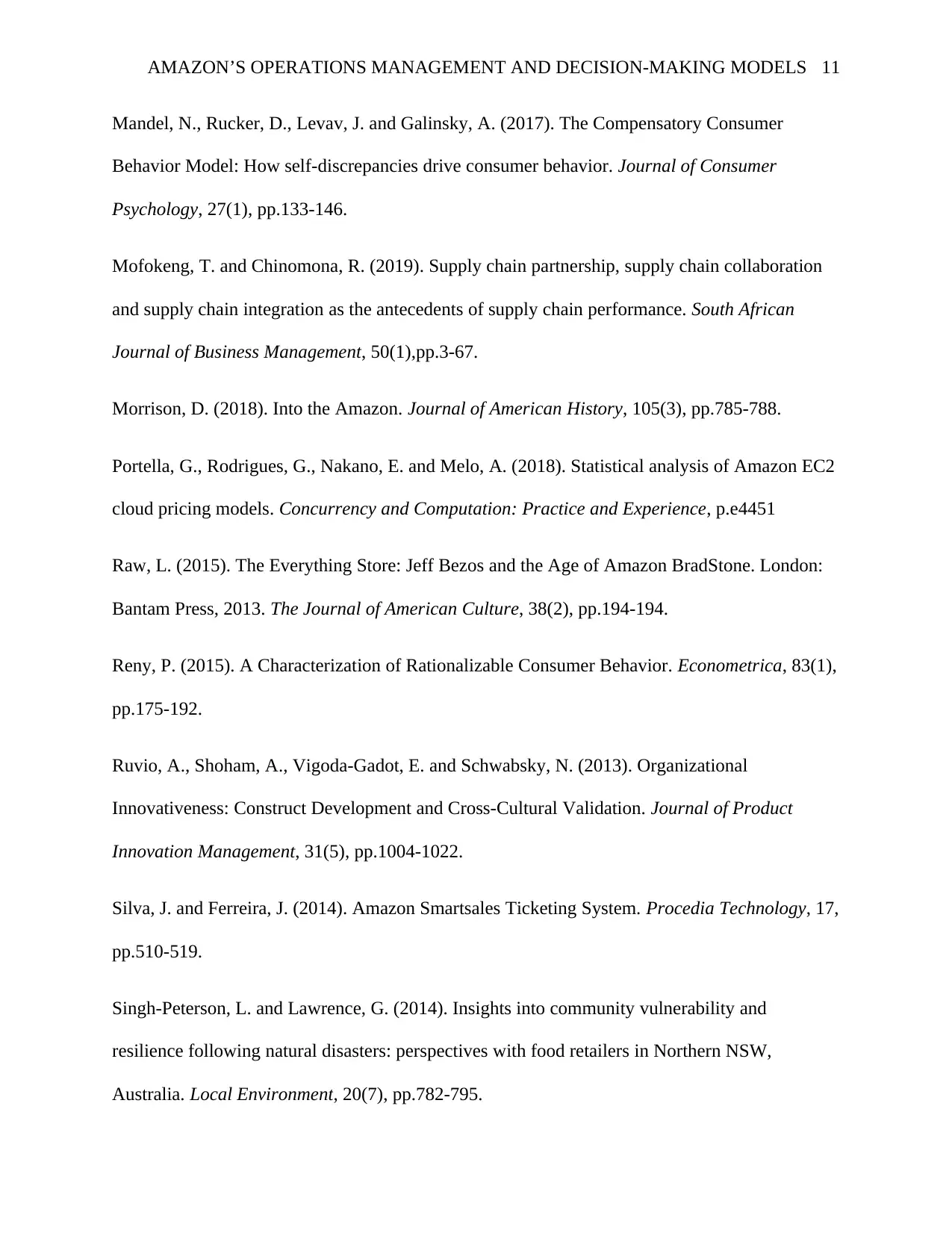
AMAZON’S OPERATIONS MANAGEMENT AND DECISION-MAKING MODELS 11
Mandel, N., Rucker, D., Levav, J. and Galinsky, A. (2017). The Compensatory Consumer
Behavior Model: How self-discrepancies drive consumer behavior. Journal of Consumer
Psychology, 27(1), pp.133-146.
Mofokeng, T. and Chinomona, R. (2019). Supply chain partnership, supply chain collaboration
and supply chain integration as the antecedents of supply chain performance. South African
Journal of Business Management, 50(1),pp.3-67.
Morrison, D. (2018). Into the Amazon. Journal of American History, 105(3), pp.785-788.
Portella, G., Rodrigues, G., Nakano, E. and Melo, A. (2018). Statistical analysis of Amazon EC2
cloud pricing models. Concurrency and Computation: Practice and Experience, p.e4451
Raw, L. (2015). The Everything Store: Jeff Bezos and the Age of Amazon BradStone. London:
Bantam Press, 2013. The Journal of American Culture, 38(2), pp.194-194.
Reny, P. (2015). A Characterization of Rationalizable Consumer Behavior. Econometrica, 83(1),
pp.175-192.
Ruvio, A., Shoham, A., Vigoda-Gadot, E. and Schwabsky, N. (2013). Organizational
Innovativeness: Construct Development and Cross-Cultural Validation. Journal of Product
Innovation Management, 31(5), pp.1004-1022.
Silva, J. and Ferreira, J. (2014). Amazon Smartsales Ticketing System. Procedia Technology, 17,
pp.510-519.
Singh-Peterson, L. and Lawrence, G. (2014). Insights into community vulnerability and
resilience following natural disasters: perspectives with food retailers in Northern NSW,
Australia. Local Environment, 20(7), pp.782-795.
Mandel, N., Rucker, D., Levav, J. and Galinsky, A. (2017). The Compensatory Consumer
Behavior Model: How self-discrepancies drive consumer behavior. Journal of Consumer
Psychology, 27(1), pp.133-146.
Mofokeng, T. and Chinomona, R. (2019). Supply chain partnership, supply chain collaboration
and supply chain integration as the antecedents of supply chain performance. South African
Journal of Business Management, 50(1),pp.3-67.
Morrison, D. (2018). Into the Amazon. Journal of American History, 105(3), pp.785-788.
Portella, G., Rodrigues, G., Nakano, E. and Melo, A. (2018). Statistical analysis of Amazon EC2
cloud pricing models. Concurrency and Computation: Practice and Experience, p.e4451
Raw, L. (2015). The Everything Store: Jeff Bezos and the Age of Amazon BradStone. London:
Bantam Press, 2013. The Journal of American Culture, 38(2), pp.194-194.
Reny, P. (2015). A Characterization of Rationalizable Consumer Behavior. Econometrica, 83(1),
pp.175-192.
Ruvio, A., Shoham, A., Vigoda-Gadot, E. and Schwabsky, N. (2013). Organizational
Innovativeness: Construct Development and Cross-Cultural Validation. Journal of Product
Innovation Management, 31(5), pp.1004-1022.
Silva, J. and Ferreira, J. (2014). Amazon Smartsales Ticketing System. Procedia Technology, 17,
pp.510-519.
Singh-Peterson, L. and Lawrence, G. (2014). Insights into community vulnerability and
resilience following natural disasters: perspectives with food retailers in Northern NSW,
Australia. Local Environment, 20(7), pp.782-795.

AMAZON’S OPERATIONS MANAGEMENT AND DECISION-MAKING MODELS 12
Teichmann, I. and Schlippenbach, V. (2014). Collusive Effects of a Monopolist's Use of an
Intermediary to Deliver to Retailers. SSRN Electronic Journal, 9(2),pp.19-78.
Teichmann, I. and Schlippenbach, V. (2014). Collusive Effects of a Monopolist's Use of an
Intermediary to Deliver to Retailers. SSRN Electronic Journal, 9(2),pp.19-78.
1 out of 12
Related Documents
Your All-in-One AI-Powered Toolkit for Academic Success.
+13062052269
info@desklib.com
Available 24*7 on WhatsApp / Email
![[object Object]](/_next/static/media/star-bottom.7253800d.svg)
Unlock your academic potential
© 2024 | Zucol Services PVT LTD | All rights reserved.



